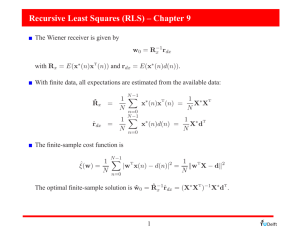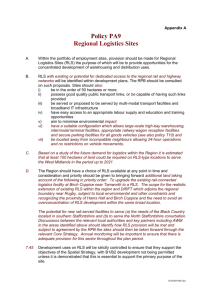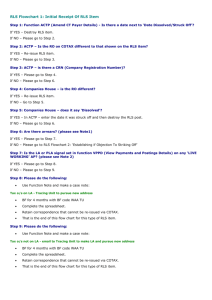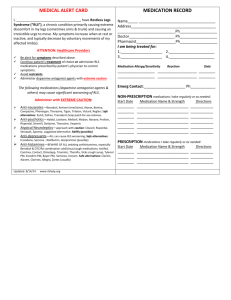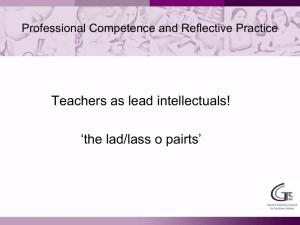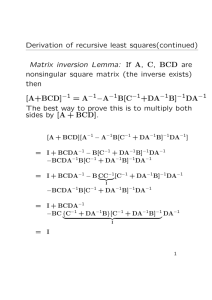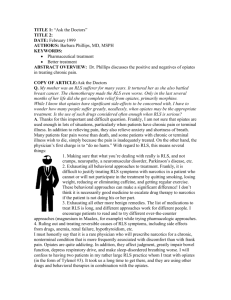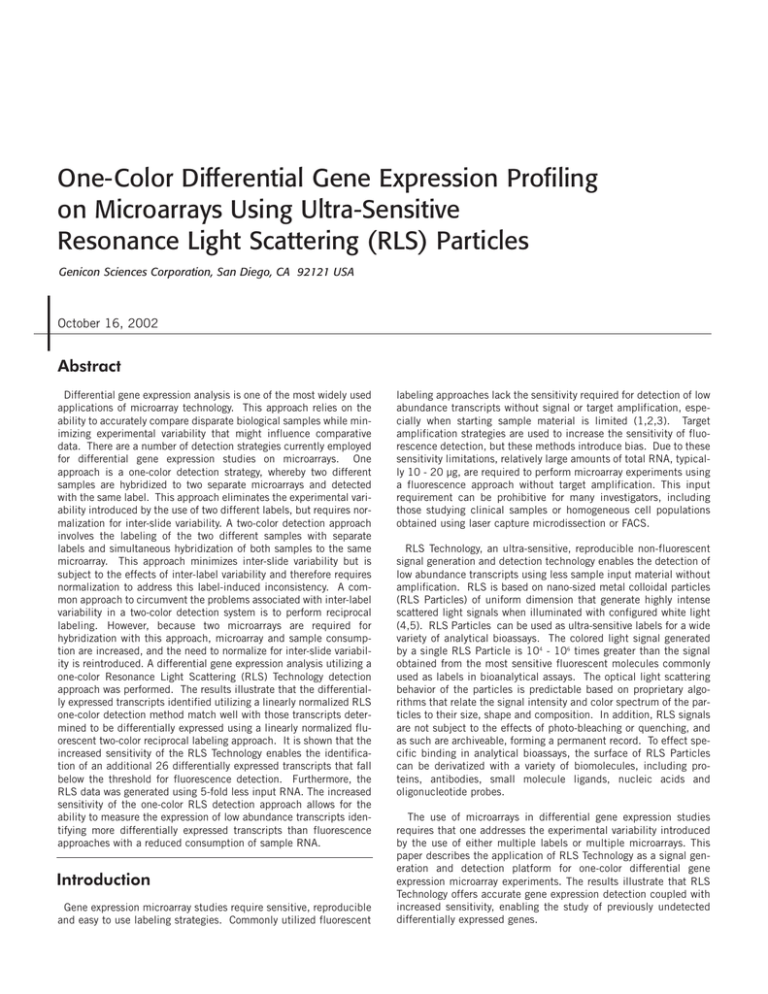
One-Color Differential Gene Expression Profiling
on Microarrays Using Ultra-Sensitive
Resonance Light Scattering (RLS) Particles
Genicon Sciences Corporation, San Diego, CA 92121 USA
October 16, 2002
Abstract
Differential gene expression analysis is one of the most widely used
applications of microarray technology. This approach relies on the
ability to accurately compare disparate biological samples while minimizing experimental variability that might influence comparative
data. There are a number of detection strategies currently employed
for differential gene expression studies on microarrays. One
approach is a one-color detection strategy, whereby two different
samples are hybridized to two separate microarrays and detected
with the same label. This approach eliminates the experimental variability introduced by the use of two different labels, but requires normalization for inter-slide variability. A two-color detection approach
involves the labeling of the two different samples with separate
labels and simultaneous hybridization of both samples to the same
microarray. This approach minimizes inter-slide variability but is
subject to the effects of inter-label variability and therefore requires
normalization to address this label-induced inconsistency. A common approach to circumvent the problems associated with inter-label
variability in a two-color detection system is to perform reciprocal
labeling. However, because two microarrays are required for
hybridization with this approach, microarray and sample consumption are increased, and the need to normalize for inter-slide variability is reintroduced. A differential gene expression analysis utilizing a
one-color Resonance Light Scattering (RLS) Technology detection
approach was performed. The results illustrate that the differentially expressed transcripts identified utilizing a linearly normalized RLS
one-color detection method match well with those transcripts determined to be differentially expressed using a linearly normalized fluorescent two-color reciprocal labeling approach. It is shown that the
increased sensitivity of the RLS Technology enables the identification of an additional 26 differentially expressed transcripts that fall
below the threshold for fluorescence detection. Furthermore, the
RLS data was generated using 5-fold less input RNA. The increased
sensitivity of the one-color RLS detection approach allows for the
ability to measure the expression of low abundance transcripts identifying more differentially expressed transcripts than fluorescence
approaches with a reduced consumption of sample RNA.
Introduction
Gene expression microarray studies require sensitive, reproducible
and easy to use labeling strategies. Commonly utilized fluorescent
labeling approaches lack the sensitivity required for detection of low
abundance transcripts without signal or target amplification, especially when starting sample material is limited (1,2,3). Target
amplification strategies are used to increase the sensitivity of fluorescence detection, but these methods introduce bias. Due to these
sensitivity limitations, relatively large amounts of total RNA, typically 10 - 20 µg, are required to perform microarray experiments using
a fluorescence approach without target amplification. This input
requirement can be prohibitive for many investigators, including
those studying clinical samples or homogeneous cell populations
obtained using laser capture microdissection or FACS.
RLS Technology, an ultra-sensitive, reproducible non-fluorescent
signal generation and detection technology enables the detection of
low abundance transcripts using less sample input material without
amplification. RLS is based on nano-sized metal colloidal particles
(RLS Particles) of uniform dimension that generate highly intense
scattered light signals when illuminated with configured white light
(4,5). RLS Particles can be used as ultra-sensitive labels for a wide
variety of analytical bioassays. The colored light signal generated
by a single RLS Particle is 104 - 106 times greater than the signal
obtained from the most sensitive fluorescent molecules commonly
used as labels in bioanalytical assays. The optical light scattering
behavior of the particles is predictable based on proprietary algorithms that relate the signal intensity and color spectrum of the particles to their size, shape and composition. In addition, RLS signals
are not subject to the effects of photo-bleaching or quenching, and
as such are archiveable, forming a permanent record. To effect specific binding in analytical bioassays, the surface of RLS Particles
can be derivatized with a variety of biomolecules, including proteins, antibodies, small molecule ligands, nucleic acids and
oligonucleotide probes.
The use of microarrays in differential gene expression studies
requires that one addresses the experimental variability introduced
by the use of either multiple labels or multiple microarrays. This
paper describes the application of RLS Technology as a signal generation and detection platform for one-color differential gene
expression microarray experiments. The results illustrate that RLS
Technology offers accurate gene expression detection coupled with
increased sensitivity, enabling the study of previously undetected
differentially expressed genes.
2
One-Color Microarray Approach for Differential Gene
Expression Analysis
To demonstrate the value of RLS Technology for differential gene
expression analysis, an experiment was performed using a one-color
labeling approach. Biotin-labeled target cDNAs from human normal
lung and lung tumor RNA sources were hybridized to separate 1.7K
human microarrays (see experimental protocol:Arrays) using 2 µg of
total RNA per sample. Anti-biotin 80 nm gold RLS Particles were
introduced to the microarray assay during post-hybridization to bind
to the hybridized biotin-labeled cDNA targets. The RLS signals on
the microarray slides were collected as a TIFF image using the
white-light/CCD based GSD-501 RLS Detection and Imaging
Instrument. A standard fluorescent two-color direct incorporation
reciprocal labeling approach using 10 µg total RNA per sample was
performed as a comparison. Fluorescent signals were collected as
a TIFF image using the Axon GenePix 4000B laser scanner. Both
the RLS and fluorescence experiments were performed in replicates
of 10 arrays. RLS TIFF images were analyzed with ArrayVisionRLS
image analysis software using Genicon Sciences’ proprietary linear
normalization feature. Fluorescence TIFF images were analyzed in
the fluorescence mode of ArrayVisionRLS also using the linear normalization feature.
Genes were scored as expressed when their feature signal intensities were measured to be 2.5 times greater than the median gene
intensity calculated for the 256 A.thaliana negative control features
on the arrays. The median %CV was also calculated for each label
and tissue sample as reported in Table 1. On average, while using
5-fold less input material, about 50% more genes were detected
using the RLS detection approach than with fluorescence. This difference in number of positive features detected by RLS vs. fluorescence is consistent with data from previous experiments across a
variety of microarray systems (data not shown). Slide-to-slide variation as indicated by median %CV, was equivalent or better than
fluorescence, indicating comparable reproducibility and precision.
To compare feature intensities between slides, a linear normalization approach was used with both RLS and fluorescence. This linear normalization technique applies a transform algorithm to the
data set of one of the arrays to normalize for assay variability. This
algorithm is generated from the slope and y-intercept of a best-fit
linear regression line that is generated when the bulk of the features
(presumed to be non-differentially expressed features) are plotted
against one another. In the one-color RLS assay, the normal lung
array with the highest overall intensity was used as the control for
normalization of the other RLS detected arrays. For the two-color
fluorescence assays, the Cy5 data set was normalized to the Cy3
data set.
Median %CV
Positive Features
Positivity Rate
(S/B > 2.5)
RLS Normal Lung
29%
38%
Cy3 Normal Lung
33%
24%
Cy5 Normal Lung
30%
24%
RLS Lung Tumor
26%
31%
Cy3 Lung Tumor
29%
17%
Cy5 Lung Tumor
33%
25%
Label and Tissue Type
Table 1: Slide-to-slide variation and positivity rates for a 2 µg input
total RNA for RLS and 10 µg input RNA for fluorescence detection on
University Health Network 1.7k human oncology microarrays
A minimum of a 2-fold change in measured expression level was
used as a threshold for establishing differential gene expression.
Statistical significance was verified by performing a t-test to confirm
a greater than 95% confidence level for those genes scored as differentially expressed. 20 genes were uniformly identified as differentially expressed and exhibited similar fold changes in expression
patterns as measured by both RLS and fluorescence detection technologies (Figure 1). In addition, 26 genes were detected to be
down-regulated by RLS Technology, but fell below the limits of
detection for one or both fluorescence data sets (Table 2). Only a
single gene was inconsistently determined as differentially expressed
by the different methods, where RLS detection showed an increase
in expression level in the lung tumor sample, while the fluorescence
data showed no change. While the RLS result for this particular gene
has not yet been confirmed by quantitative RT-PCR, it is interesting
to note that the amplified material comprising this array feature was
originally isolated from a human lung large cell carcinoma (Genbank
accession number BE877666). RNA samples have been retained
for confirmation of this gene's differential gene expression using
outside quantitative RT-PCR techniques. In summary, the number
of differentially expressed genes more than doubles (47 vs. 20) when
using one-color RLS detection technology when compared with fluorescence, despite using 5-fold less input material per sample.
Of the 26 genes that were detected by RLS to be differentially
expressed and were below the limits of detection for fluorescence,
a subset of 5 randomly selected genes, were evaluated by manual
quantitative RT-PCR techniques. Though the total RNA samples
were treated with DNase I prior to purchase, a second DNase I treatment was performed as an additional precaution to remove any
remaining genomic DNA contamination. This total RNA was then
converted to cDNA using a poly d(T) primer and standard protocols.
PCR reactions using gene specific primers and cDNA as a template
were stopped every 5 cycles up to 40 cycles. The PCR products
were separated on gels and quantitated by SYBR green staining. All
5 genes that were detected by RLS and undetected by fluorescence
produced measurable products between 30 and 35 cycles for normal lung tissue and ranged from detectable at 35 cycles to undetectable at 40 cycles in human lung tumor tissue. Both a no RT
enzyme and a template-free reaction were run in parallel as negative controls. These reactions were uniformly negative for the presence of PCR amplicons, indicating that the amplicons generated
from the cDNA samples were derived from mRNA and not from any
DNA contamination. The results of these RT-PCR experiments indicate that the mRNAs detected utilizing RLS were indeed present in
the normal lung RNA sample. These RT-PCR results provide further
evidence that RLS Technology is capable of reliably detecting lower
abundance transcripts than are typically detected using fluorescence technology.
Detection Method for Differentially Expressed Genes
Differentially expressed by both RLS and fluorescence
Differentially expressed by RLS, below detection
threshold for fluorescence
Differentially expressed by RLS, not by fluorescence
Number of
Genes
20
26
1
Total number of differentially expressed genes detected
by fluorescence
20
Total number of differentially expressed genes detected
by RLS
47
Table 2: Comparison of differentially expressed genes detected by
RLS and fluorescence.
3
10.00
# Positives (S/B > 2.5)
Up-Regulated
Non-Differentially
Expressed
1.00
Down-Regulated
0.10
Cy5 Tumor/Cy3 Lung
Cy3 Tumor/Cy5 Lung
RLS Tumor/RLS Lung
RLS Tumor/RLS Lung CyDye Undetected
0.01
0
10
20
30
40
50
Gene Number
Figure 1: Differential gene expression using a one-color RLS detection and a fluorescent two-color reciprocal labeling detection approach. Red
triangles represent the 26 array features which were scored as differentially expressed by RLS detection, but fell below the threshold for detection
with fluorescence.
Conclusion
RLS Technology is an effective detection method for one-color differential gene expression, providing sensitivity that enables more
genes to be accurately scored as differentially expressed. When
coupled with a linear normalization strategy, a one-color RLS detection approach enables detection of differentially expressed genes as
accurately as a two-color fluorescent reciprocal method, eliminating
inter-label variability and providing a solution to address inter-slide
variation. The fold-differences in gene expression measured by RLS
with 2 µg of starting material were consistent with those measured
by fluorescence detection using 10 µg of starting material. The
increased sensitivity of RLS Technology enables the detection of
lower abundance transcripts that were not detected by fluorescence, even when using 5-fold more starting material. A total of 26
additional differentially expressed genes were detected using RLS
Technology. Confirmatory RT-PCR studies were performed on a subset of the RLS positive genes, assuring the validity of the RLS data.
Finally, the increased sensitivity of RLS Technology lowers the
amount of starting material required for microarray analysis.
Reduced sample consumption enables either more experimental
replicates to be performed to increase statistical accuracy, or allows
other assay types to be performed with the same sample. Thus,
RLS Technology offers an effective and significant improvement to
standard fluorescence detection methods of gene expression using
microarrays.
Materials and Methods
Arrays
Human cDNA microarrays containing 3,840 elements printed on
Corning GAPS II slides (Corning Inc., Corning, NY) were purchased
from the University Health Network Microarray Centre (Toronto,
Canada). The 3,840 elements consist of 1,728 unique human
cDNA clones spotted in duplicate, 256 elements derived from an
Arabidopsis thaliana cDNA clone for use as negative controls and
128 elements of 3X SSC spotting buffer. Slides were postprocessed by UV crosslinking and assayed using the One-Color
Microarray Toolkit Protocol (Genicon Sciences, San Diego, CA).
cDNA Target Labeling and Purification:
Reagents:
The following reagents and materials were used to generate labeled
target cDNAs: human lung total RNA, (Ambion, Austin, TX); human
lung tumor total RNA, (Invitrogen, Carlsbad, CA); Superscript II
reverse transcriptase, RNaseOUT, 5X first-strand buffer, 0.1 M
dithiothreitol, oligo d(T)(12-18) primers (Invitrogen, Carlsbad, CA);
Cy3 and Cy5 dUTP (Amersham Pharmacia Biotech, Piscataway,
NJ); Biotin-11-dUTP (Enzo Diagnostics, Farmingdale, NY); sodium
hydroxide, Tris-HCl (Sigma, St. Louis, MO); QIAquick PCR
Purification Kit, (QIAGEN, Valencia, CA).
Protocol:
cDNA targets were prepared for each RNA and label type by direct
incorporation using (per reaction) 7.5 µg total RNA, 0.75 µg oligo
d(T)(12-18) and nuclease free water to 15 µl. The mix was incubated at 70°C for 10 minutes, chilled to 42°C for 2 minutes before
adding reverse transcriptase mix (6 µl, 5X first-strand buffer; 3 µl,
0.1 M dithiothreitol; 0.9 µl RNaseOUT; 0.6 µl, 50XdNTPs (25 mM
dATP, dGTP, dCTP, 10 mM dTTP); 3 µl, 1mM Biotin-11-, Cy3 or Cy5
dUTP; 1.5 µl SuperScript II) and then incubated for 60 minutes at
42°C. The reaction was terminated by addition of 5 µl 1N NaOH
and incubating for 10 minutes at 70°C, chilled and neutralized with
5 µl 1M Tris-HCl, pH 7.4. cDNA targets were purified using the
QIAquick PCR Purification Kit using the recommended protocol and
eluted with 50 µl buffer EB.
Pre-Hybridization, Hybridization, and Wash Conditions
40 glass microarrays from a single printing lot were pre-hybridized
according to the Genicon Sciences One-Color Microarray Toolkit's
Pre-Hybridization Protocol (Genicon Sciences, San Diego, CA). The
4
=
=
slides were rinsed in DI water and dried under a stream of clean, filtered air. Labeled cDNA from human lung or human lung tumor
total RNA was prepared and hybridized according to the Genicon
Sciences One-Color Microarray Toolkit's Hybridization Protocol.
Briefly, 10 slides at 2 µg total RNA input for human lung, 10 slides
at 2 µg total RNA input for human lung tumor, 10 slides at 10 µg
total RNA input Cy3 lung 10 µg Cy5 lung tumor, and 10 slides at
10 µg total RNA input for Cy5 human lung 10 µg Cy3 lung tumor
had their respective hybridization mixtures prepared, denatured at
95°C for 5 minutes, and applied utilizing LifterSlips (Erie Scientific,
Portsmouth, NH). All slides were incubated at 42°C for 16 hours
in a hybridization chamber, and subsequently washed according to
the Genicon Sciences One-Color Microarray Toolkit's PostHybridization Wash Protocol. The fluorescent-labeled slides were
rinsed in DI water and dried under a stream of clean, filtered air.
RLS Particle Binding
RLS Particle Binding was performed according to the Genicon
Sciences One-Color Microarray Toolkit Protocol (Genicon Sciences,
San Diego, CA). Briefly, slides were blocked with RLS Blocking
Solution, and then 80 nm gold RLS Particles functionalized with
anti-biotin antibodies were added for a 60 minute binding step.
After a brief wash to remove non-specifically bound RLS Particles,
a final rinse in DI water and drying under a stream of clean, filtered
air, the slides were archived by dipping the slides into Archiving
Solution.
Array Imaging
Cy3 and Cy5 labeled arrays were read with a GenePix 4000B scanner (Axon, Union City, CA) at 10 µm resolution, 100% Laser Power,
and PMT 600 volts to obtain maximal signal intensities at high target input without signal saturation. Total read time for each slide
was approximately 1.75 minutes. RLS labeled arrays were read
with a white light/CCD-based GSD-501 RLS Detection and Imaging
instrument, (Genicon Sciences, San Diego, CA) at 10 µm resolution
and 0.4 second exposure time. The total read time for each slide
was approximately 0.5 minutes. The resulting images were analyzed
using ArrayVisionRLS image analysis software (Genicon Sciences,
San Diego, CA, and Imaging Research Inc., St. Catherines, Canada).
Analysis
ArrayVisionRLS parameters used for analysis include: MTM density as the principal measure with a MAD threshold of 6, spot segmentation enabled, obvious outliers confirmed visually, flagged, and
excluded from analysis. Background was defined as the median
MTM density from the 256 A. thaliana features (camera bias of 100
subtracted from all MTM density measures for RLS calculations). A
signal to background (S/B) ratio greater than 2.5 was defined as a
detected feature. The average number of detected features at the
specific input levels for the 10 replicate arrays was calculated as an
output for comparison between labels.
Linear Normalization
Linear normalization of RLS detected microarrays: the array with
hybridized normal lung targets that had the highest overall intensity was used as the control. Since these pre-spotted arrays were not
printed with positive control features for normalization, linear normalization transform parameters (slope and intercept) were derived
from pairs of presumably non-differentially expressed features on
the differing slides. All replicate lung tumor features were linearly
For inquiries regarding RLS Technology or data presented
herein, please contact Genicon Sciences Corporation at
1.866.GENICON, or techsolutions@geniconsciences.com.
10/02
normalized to the control array using the derived linear correlation
transform parameters. For each pair of arrays being normalized, a
scatter plot was generated using the features described. The normal lung features were placed on the independent x-axis and the
lung tumor features were placed on the dependent y-axis. The slope
and y-intercept of the best-fit linear regression line was determined.
Subsequently, each feature on the lung tumor array was transformed
by the equation y'=(y-b)/m where: y' is the normalized, and y is the
original lung tumor feature expression value; b is the y-intercept;
and m is the slope of the best-fit linear regression line. For twocolor fluorescence normalization, the Cy5 data set was normalized
to the Cy3 data set using the same parameters as RLS linear normalization.
Quantitative RT-PCR
DNase I treated, RT-PCR certified total RNA from normal human
lung (Ambion, Austin, TX) and human lung tumor (Invitrogen,
Carlsbad, CA) was purchased. The samples of total RNA were treated a second time in-house with DNase I as an additional step to
remove genomic DNA contamination in the samples by incubating
14 µg total RNA with 1.5 µl DNase I, 0.5 µl RNaseOUT and 4 µl
5X first-strand buffer for 15 minutes at 37°C. The reactions were
terminated by heating at 95°C for 5 minutes. An aliquot of 1.4 µg
was removed for use as a reverse transcriptase negative control
(-RT) while the rest of the total RNA was converted to cDNA by
adding 1.5 µg oligo d(T)(12-18) and water to 30 µl. The reaction was
heated to 70°C for 10 minutes, then cooled to 42°C before the
addition of reverse transcriptase mix (5X first-strand buffer, 8.4 µl;
0.1 M dithiothreitol, 6 µl; 50XdNTPs {25 mM dATP, dGTP, dCTP,
dTTP}; SuperScript II, 3 µl) and incubated for 60 minutes at 42°C.
The reaction was terminated by adding 10 µl 1N NaOH and incubating for 10 minutes at 70°C, chilled and neutralized with 10 µl
1M Tris-HCl, pH 7.4. Probes were purified using the QIAquick PCR
Purification Kit using the recommended protocol and eluted with
50 µl EB buffer. PCR reactions contained 125 - 250 nM each gene
specific primer, 10 - 50 ng cDNA, 25 µl 2X HotStarTaq Master Mix,
up to 6 mM MgCl2 and nuclease free water to 50 µl. Replicate
reactions were stopped every 5 cycles up to 40 cycles with a no
template reaction and a -RT reaction run to 40 cycles serving as
negative controls for each primer pair. The PCR products were separated on 10% TBE Novex gels, stained with SYBR Green I stain,
imaged and quantified with an AlphaImager 2200 (Alpha Innotech
Corporation, San Leandro, CA).
References
1. Van Hummelen P. et al. (2002) Biotechniques. 32(6),
1330-1340.
2. Swaroop et al. (2002) Molecular Vision. 8, 130-137.
3. Mahadevappa, M. and Warrington, J.A. (1999) Nat.
Biotechnol. 17, 1134-1136.
4. Yguerabide, J. and Yguerabide, E.E. (1998) Anal. Biochem.
262, 137-156.
5. Yguerabide, J. and Yguerabide, E.E. (1998) Anal. Biochem.
262, 157-176.
Trademarks
Genicon Sciences, RLS Particles, One-Color Microarray Toolkit,
and GSD-501 are trademarks of Genicon Sciences Corporation.
Copyright 8 2002 Genicon Sciences Corporation.
All rights reserved.


